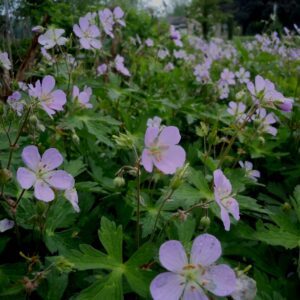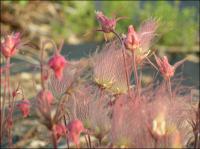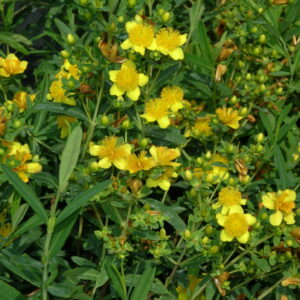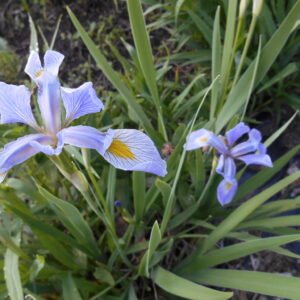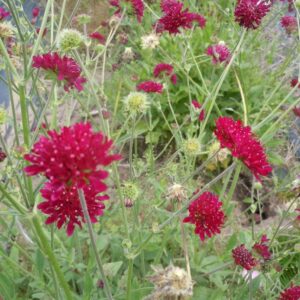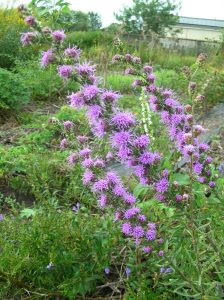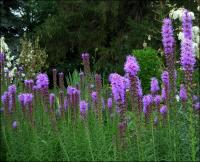Wisconsin Native
Showing 57–64 of 108 results
-
Geranium maculatum American Cranesbill, Wild geranium, Spotted geranium Z 3-8
Saucer-shaped, five rose-pink to lilac oval petals with darker veins to the center, guiding pollinators to its nectar, surround ten upright stamens bearing yellow pollen in the center bloom in mid to late spring and early summer if cool.
Saucer-shaped, five rose-pink to lilac oval petals with darker veins to the center, guiding pollinators to its nectar, surround ten upright stamens bearing yellow pollen in the center bloom in mid to late spring and early summer if cool.
Size: 24" x 18"
Care: Full sun to part shade in moist to moist well-drained soil
Native: East North America, Wisconsin native.
Wildlife Value: Nectar and pollen source for hummingbirds, bees and butterfliesNative Americans taught colonists to use the plant to cure diarrhea, dysentery and hemorrhaging. Also used on sores, open wounds, canker sores and sore feet. The Choctaw prescribed it for venereal disease. Sent to Europe in 1732 This species collected by French planthunter André Michaux (1746-1802) who spent 11 years collecting plants in the US. Jefferson asked John Bartram to obtain seeds, 1786. Pressed specimen in Emily Dickinson’s herbarium.
-
Geum triflorum Prairie smoke, Old Man’s whiskers Z 1-8
Pale purplish-pink dangling cup-shaped flowers in spring to early summer, followed by hair-like, pink seed heads like the hair on a troll doll.
Pale purplish-pink dangling cup-shaped flowers in spring to early summer, followed by hair-like, pink seed heads like the hair on a troll doll.
Size: 10" x 8" but slow to grow to this width
Care: sun in well-drained to moist well-drained soil
Native: all of northern No. America, Wisconsin native
Awards: Great Plants for Great PlainsIntroduced to gardens in 1609. Many Native American medicinal uses. Blackfeet used it to cure coughs, skin sores and wounds on people and horses, swollen eyes, canker sores, and fuzzy thinking in people. Crushed, ripe seeds made a perfume. Okanagan-Colville women made a love potion from the roots, as well as curing vaginal yeast infections. The Eastern Cascades of Canada brewed a medicinal tea for eye-wash, sore throats and general aches from the plant. Sioux used it for many ailments: sore eyes, canker sores, sore throat, perfume, wounds, and added it to mixtures of plants for smoking Collected by Meriwether Lewis on June 12, 1806 on the Weippe Prairie, not far from the villages of the Nez Perce in Idaho.
-
Hypericum kalmianum Kalm’s St. Johns wort SHRUB Z 4-7
Yellow saucers with a puff of showy prominent stamens in mid to late summer, compliment the glaucous blue leaves on this mounding shrub.
Yellow saucers with a puff of showy prominent stamens in mid to late summer, compliment the glaucous blue leaves on this mounding shrub.
Size: 3-4’ x 3-4’
Care: sun to shade in well-drained to moist well-drained soil. Blooms on new growth so prune in late winter to early spring as far back as you wish.
Native: Quebec to WI, S. to IL, Wisconsin native.
Wildlife Value: attracts bees and butterflies
Awards: Great Plants for Great PlainsThe name Hypericum comes from Greek hyper meaning “above”, and eikon, meaning “icon or image”. The yellow flowers of some species were placed above images to ward off evil spirits, and according to legend, Satan pierced the leaves in revenge. This species collected by & named for Peter Kalm, Swedish plant hunter, on his expedition in North America before 1753. Offered for sale in Bartram Garden’s 1783 Broadside, America’s 1st plant catalog. David Douglas (Douglas fir guy) also collected this at Niagara Falls per William Jackson Hooker.
**LISTED AS OUT OF STOCK BECAUSE WE DO NOT SHIP THIS ITEM. IT IS AVAILABLE FOR PURCHASE AT OUR RETAIL LOCATION.
-
Iris versicolor Blue flag Z 3-9
Purple, lavender or blue flowers in June
Purple, lavender or blue flowers in June
Size: 36" x 12"
Care: sun, moist to moist well-drained soil
Native: Eastern United States, Wisconsin nativeIris is named after the Greek goddess who accompanied the souls of women to the Elysian Fields by way of the rainbow. Her footprints left flowers the colors of the rainbow. Iris means the eye of heaven. Omaha Indians used the roots topically to cure earaches. Other tribes applied a poultice to cure sores and bruises. Root is poisonous. Cultivated in gardens since the 1700’s.
-
Knautia macedonica syn. Scabiosa rumelica Pincushion plant Z 5-9
Claret pincushions float at the tips of airy wands all summer & fall
Claret pincushions float at the tips of airy wands all summer & fall
Size: 2- 3’ x 10”
Care: sun in well-drained soil. Keep compact by cutting back to 10” in spring, if you wish
Native: Central Europe
Wildlife Value: attracts butterflies and beesKnautia named for German doctor & botanist Christoph Knaut (1656-1716) who published a method of classifying plants. Collected before 1879
-
Lathyrus japonicus v. maritimus Beach pea Z 3-6
Magenta pea flowers June through August on its trailing stems. A legume, it puts nitrogen in the soil fertilizing plants growing nearby.
OUT OF STOCK – EMAIL FOR AVAILABILITY
Magenta pea flowers June through August on its trailing stems. A legume, it puts nitrogen in the soil fertilizing plants growing nearby.
Size: 18-24” tall but lays on ground, not upright
Care: sun in well-drained soil. Drought tolerant.
Native: all northern states from the Atlantic to the Pacific, Wisconsin native. (It seems strange that a variety of a plant native to Japan grows as a native in North America. The species, although named “Japonica” is circumpolar, native in the entire northern hemisphere.)
Wildlife Value: pollinated by bees, primarily bumblebeesIroquois cooked the stalks and leaves to remedy rheumatism. Taxonomic mess. First described and named in 1735 then another name in 1824, now changed again to its current name.
-
Liatris aspera Rough blazing star Z 4-9
Feathery purple buttons along tall spike
OUT OF STOCK
Feathery purple buttons along tall spike in late summer: August-October, after all other Liatris are done flowering.
Size: 24”-30” x 12”-18”
Care: Sun in well-drained soil
Native: So. Canada, much of eastern 3/4th of U.S.
Wildlife Value: attract butterflies (favorite nectar for Monarchs and Buckeyes) & hummingbirds.Aspera is Latin meaning rough. 1st collected by Frenchman André Michaux (1746-1802) who spent 11 years in America collecting hundreds of new plants.
-
Liatris spicata Blazing star, Gayfeather, Button snakeroot Z 3-8
Rosy purple spikes in July and August, a flower arranger’s dream
Rosy purple spikes in July and August, a flower arranger’s dream
Size: 2-3' x 18"
Care: Full sun in moist to well-drained soil.
Native: Eastern and southern U. S., Wisconsin native
Wildlife Value: favorite nectar source for Buckeye butterflies & host for caterpillars of Painted lady, Fritillaries, Skippers, Sulphurs, Coppers & Checkerspot butterflies.Native Americans used roots medicinally for backaches, colic, dropsy and to strengthen a weak heart. The Dakota recognized this as an indication “when the flower is blue-red that corn is good to eat.” Nicollet Diary, August 13, 1838. The dried root reputedly repelled moths from stored clothes. First collected by English naturalist Mark Catesby and cultivated since 1732. Grown at America’s 1st botanic garden, Elgin Botanic Garden 1811.

